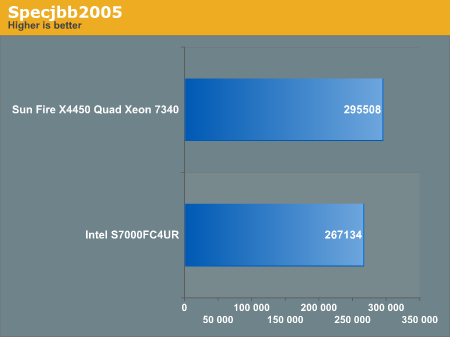Sun Fire X4450: Challenging the HP and IBM bastion
by Johan De Gelas on May 25, 2008 12:00 PM EST- Posted in
- IT Computing
Power Consumption
Power consumption is one of the factors that will determine the cost of operation. To measure power consumption, we made sure that both systems use the same configuration:
- Four Xeon MP E7340 (quad-core, 2.4GHz, 2x 4MB L2)
- 32GB (8x 4GB) of 667MHz FBDIMM
- Two 2.5 inch 73GB 10.000 RPM SAS hard disks
- A 1+1 Redundant PSU configuration
As we did not have the HP ProLiant 585 G5 in the labs, we also use the power calculators of each manufacturer (Sun, Dell and HP) to get an idea of the power consumption. We didn't find a similar power calculator from IBM.
| Server Power Consumption: calculated | |||
| CPU Load | Sun Fire x4450 | HP ProLiant DL585G5 | Dell PowerEdge R900 |
| 0% | 346 | 371 | 390 |
| 85% | 550 | 631 | 878 |
| 100% | 586 | 679 | 944 |
Power calculator numbers are of course not very accurate. Some manufacturers may use a large safety margin, other might publish low numbers as a way of convincing customers. It gives us a rough idea.
Let us see how the "power calculator" numbers compare with the reality in our lab. We measured peak power consumption running Specjbb2005 when the CPUs were at 85% and 100%.
| Server Power Consumption: measured | |||
| CPU Load | Sun Fire x4450 | Intel S7000FC4UR | Difference Intel vs. Sun |
| 0% | 311 | 391 | +26% |
| 85% | 490 | 571 | +17% |
| 100% | 534 | 631 | +18% |
Sun’s power consumption is pretty low with these CPUs, but the Dell numbers we got from Dell’s capacity planner seem to be very high if you consider that they should be close to the Intel server. Sun's power calculator numbers seem to be accurate, while Dell's numbers have a high safety margin.
The fans seem to be one reason the difference between the 2U Sun machine and 4U Intel machine is higher at idle. Once the CPUs are working at full load, the fans inside the Sun have to work harder to get the heat out of the cramped 2U box. We measured up to 715W at peak if you use four Xeon MP x7350 (TDP: 130W) instead of four Xeon MP E7340 (TDP:80W). The fans were screaming quite loud, so our advice is to use 80W TDP CPUs in this server - your fans will last a lot longer.
Performance
Extensive performance measurements are only interesting if they really test the platform and not just the CPUs. Sun, HP, IBM, and Dell all use the same Intel CPUs and the only way they can influence the performance of the platform is by designing either the motherboard or tuning it as well as possible. IBM is the only one of these four that takes it further: it designs the chipset too. With the exception of the IBM servers, we shouldn't expect big differences in real world performance except for applications that really stress the memory subsystem. To magnify the small expected performance differences, we used our multi-threaded, 64-bit Linux Stream binary (courtesy of Alf Birger Rustad) based on v2.4 of Pathscale's C Compiler, compiled with the following switches:
-Ofast -lm -static -mp
We tested with 16 threads on a SUSE Linux SLES 10 SP1, 64 bit.
| Multi-threaded Stream bandwidth measurement | |||
| Stream | Sun Fire x4450 | Intel S7000FC4UR | Difference Sun vs. Intel |
| Copy | 8651 | 7823 | +11% |
| Scale | 8618 | 7623 | +13% |
| Add | 9189 | 8560 | +7% |
| Triad | 9162 | 7791 | +18% |
Both Sun and Intel offer a "high bandwidth" option in the BIOS. However, it seems to decrease bandwidth instead of raising it in our testing, so we left it off (default setting).
Despite the fact that the BIOS settings were identical (prefetcher off, high bandwidth off, adjacent Cache line prefetch off) and the fact that we are using exactly the same software configuration, the Sun x4450 outperforms the Intel board by more than 10% in this memory bandwidth test. The question is if this is reflected in a more real world test which is known to be limited by memory bandwidth like SPECjbb2005. We used almost the exact same setup as we described here in great detail. The only changes were:
- We use the BEA JRockit R27.5.0-5 Linux x86_64)
- We do not use the SUN JVM as Sun is about to release a new JVM version which is significantly faster than the current one. This new JVM (1.6.0_06-prelease) allows Sun to claim the crown in SPECjbb2005 as you can see here.
- We changed one of our java parameters: -Xms1800m -Xmx1800m -Xns1300m -XXaggressive -XXlazyunlocking -Xgc:genpar -XXtlasize:min=4k,preferred=512k -XXcallprofiling
We use Xns = 1.3 GB instead of 1.5 GB (used in previous reviews) as this leaves more room for the old space (Xms minus Xns) which avoid excessive Garbage Collecting. Our thanks goes to Henrik Stahl for pointing this out.

To our surprise, Sun’s bandwidth advantage was also reflected in our SPECjbb2005 test: the Sun machine is a full 10% faster. We will explore the performance capabilities of this kind of server in the next article and try to find out more. But this performance advantage was quite unexpected.










0 Comments
View All Comments